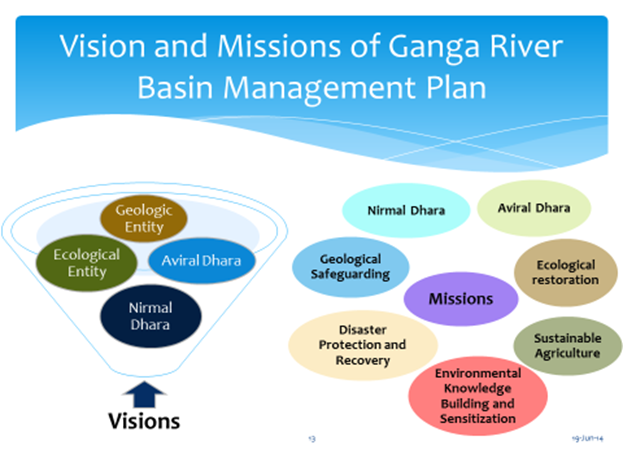Rejuvenation of Ganga
Rejuvenation of Ganga
Ganga-A National River
The Himalayas are the source of three major Indian rivers namely the Indus, the Ganga and the Brahmaputra. Ganga drains a basin of extraordinary variation in altitude,climate, land use, flora & fauna, social and cultural life. Ganga has been a cradle of human civilization since time immemorial. Millions depend on this great river for physical and spiritual sustenance. People have immense faith in the powers of healing and regeneration of the Ganga. It is arguably the most sacred river in the world and is deeply revered by the people of India.
The River plays a vital role in religious ceremonies and rituals. To bathe in Ganga is a lifelong ambition of many who congregate in large numbers for several river centered festivals such as Kumbh Mela and numerous Snan (bath) festivals.
Location
Ganga basin is the largest river basin in India in terms of catchment area, constituting 26% of the country's land mass (8,61,404 Sq. km) and supporting about 43% of its population (448.3 million as per 2001 census).
The basin covers 11 states viz., Uttarakhand, U.P., M.P., Rajasthan, Haryana, Himachal Pradesh, Chhattisgarh, Jharkhand, Bihar, West Bengal and Delhi.The current focus of world bank funded National Ganga River Basin Projects (NGRBP) of NMCG is on five major states on the main stem of river Ganga namely Uttarakhand, Uttar Pradesh, Jharkhand, Bihar and West Bengal.
|
States |
Drainage area(km) |
|
Uttarakhand and Uttar Pradesh |
294,364 |
|
Madhya Pradesh and Chhattisgarh |
198,962 |
|
Bihar and Jharkhand |
143,961 |
|
Rajasthan |
112,490 |
|
West Bengal |
71,485 |
|
Haryana |
34,341 |
|
Himachal Pradesh |
4,317 |
|
Delhi |
1,484 |
|
Total |
861,404 |
About NMCG
National Mission for Clean Ganga (NMCG) is the implementation wing of National Ganga River Basin Authority (NGRBA). At national level NMCG is the coordinating body and is being supported by States Level Program Management Groups (SPMGs) of UP, Uttarakhand, Bihar and West Bengal which, are also registered as societies under Societies Registration Act, 1860 and a dedicated Nodal Cell in Jharkhand.
The area of operation of NMCG shall be the Ganga River Basin, including the states through which Ganga flows, as well as the National Capital Territory of Delhi. The area of operation may be extended, varied or altered in future, by the Governing Council to such other states through which major tributaries of the river Ganga flow, and as the National Ganga River Basin Authority (NGRBA) may decide for the purpose of effective abatement of pollution and conservation of the river Ganga.
The aims and objectives of NMCG
- To ensure effective abatement of pollution and rejuvenation of the river Ganga by adopting a river basin approach to promote inter-sectoral co-ordination for comprehensive planning and management and
- To maintain minimum ecological flows in the river Ganga with the aim of ensuring water quality and environmentally sustainable development.
Vision and Key Function
Vision
The Vision for Ganga Rejuvenation constitutes restoring the wholesomeness of the river defined in terms of ensuring “Aviral Dhara” (Continuous Flow”), “Nirmal Dhara”(“Unpolluted Flow”), Geologic and ecological integrity.
Key Functions
To achieve the objectives, NMCG shall carry out the following key functions namely:
- Implement the work programme of National Ganga River Basin Authority(NGRBA).
- Implement the World Bank supported National Ganga River Basin Project.
- Coordinate and oversee the implementation of projects sanctioned by Government of India under NGRBA.
- Undertake any additional work or functions as may be assigned by MoWR,RD &GJ in the area of conservation of river Ganga.
- Make rules and regulations for the conduct of the affairs of the NMCG and add or amend, vary or rescind them from time to time.
- Accept or to provide any grant of money, loan securities or property of any kind and to undertake and accept the management of any endowment trust, fund or donation not inconsistent with the objectives of NMCG.
- Take all such action and to enter all such actions as may appear necessary or incidental for the achievements of the objectives of the NGRBA.
Ganga River Basin Management Plan
 The Plan is being prepared with the objectives of taking comprehensive measures for restoration of the wholesomeness of the Ganga ecosystem and improvement of its ecological health, with due regard to the issue of competing water uses in the river basin.
The Plan is being prepared with the objectives of taking comprehensive measures for restoration of the wholesomeness of the Ganga ecosystem and improvement of its ecological health, with due regard to the issue of competing water uses in the river basin.
The wholesomeness of the river can be grasped in terms of four defining concepts:
Aviral Dhara (Continuous Flow)
Nirmal Dhara (Unpolluted Flow)
Geologic Entity
Ecological Entity
Source: Ministry of Water Resources, River Development & Ganga Rejuvenation
Last Modified : 9/14/2023
This topic provides information about Ganga Basin.
This topic provides overview of he district Osmana...
This topic provides overview of he district Vishak...
